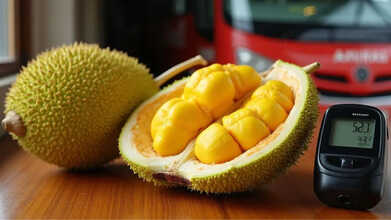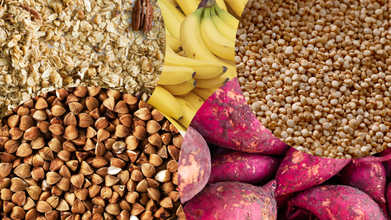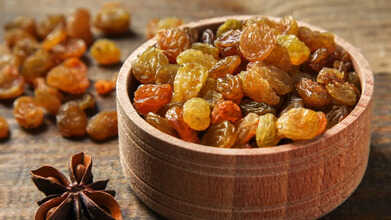- Health Conditions A-Z
- Health & Wellness
- Nutrition
- Fitness
- Health News
- Ayurveda
- Videos
- Medicine A-Z
- Parenting
- Web Stories
Can A Jackfruit Get You Drunk? 3 Kerala Drivers Failed Breath Analyzer Test After Consuming This Fruit

It’s not every day that a fruit finds itself at the center of a public transport controversy. However, in Kerala, three KSRTC (Kerala State Road Transport Corporation) drivers faced an unusual predicament: they failed a mandatory breathalyzer test before duty, despite claiming complete sobriety. The surprising culprit? Overripe jackfruit.
This bizarre incident has stirred questions across health, nutrition, and law enforcement circles—can jackfruit actually make you drunk?
The Incident That Sparked It All
The confusion began at the Pandalam depot in Kerala’s Pathanamthitta district. Three KSRTC drivers tested positive for alcohol during their routine breath test. Shockingly, they swore they hadn’t consumed any alcohol. One of them, in a state of disbelief, even volunteered for a blood test to prove his innocence.
Also Read: Coca-Cola To Launch Cane Sugar Version In US: Is It Really Healthier?
Officials were initially skeptical—until a surprising experiment cleared the air. A staff member who had tested negative earlier was asked to consume the same jackfruit. Post-snack, he too registered a positive breathalyzer reading. This led the officials to conclude that the overripe jackfruit, not alcohol consumption, was behind the results.
Blame It on Natural Fermentation
The variety in question was ‘thenvarikka’—a jackfruit known for its honey-like sweetness.
Experts explained that overripe jackfruit undergoes a natural fermentation process due to its high sugar content. The glucose and fructose in the fruit can convert to ethanol, especially when the fruit is overly ripe or improperly stored.
This fermentation can result in trace levels of alcohol, enough to confuse a sensitive breathalyzer but not nearly enough to cause intoxication in humans. It’s similar to what happens with overly ripe bananas or fermented foods like kimchi and idli batter.
Foods That Can Trigger False Positives
This isn’t the first time food has clashed with technology. Breathalyzers, although useful, aren’t always foolproof. According to experts, several foods and drinks can skew test results:
- Overripe fruits such as bananas, mangoes, durians, and of course, jackfruit.
- Fermented foods including kimchi, sauerkraut, yogurt, and dosa/idli batter.
- Alcohol-based mouthwash or non-alcoholic beer.
- Vinegar-rich dishes or food cooked in alcohol (like rum cake).
- Protein bars and energy drinks with sugar alcohols.
The common factor? Trace ethanol or fermentation byproducts. While these generally don’t impair your faculties, they can momentarily confuse breathalyzer sensors.
Is Jackfruit Dangerous to Eat? Not at All
Before you panic and toss your jackfruit stash, let’s get one thing clear: jackfruit is perfectly safe and nutritious. In fact, it’s rich in vitamin C, potassium, fiber, and antioxidants. It supports digestion, boosts immunity, and may help regulate blood pressure.
The issue here lies not in the fruit itself, but in the ripeness and timing. Most people don’t eat jackfruit at the overripe, fermented stage. But when they do, especially in large amounts, and shortly before an alcohol test—there’s a slim chance of triggering a false reading.
Lessons for Breathalyzer Policies
The KSRTC episode highlights an important need for contextual judgment in zero-tolerance systems. While breathalyzers are crucial for road safety, depending solely on them without investigating anomalies can wrongly penalize innocent individuals.
Transport authorities may need to revise protocol: conduct secondary tests like blood alcohol analysis, or allow for food-history reporting before taking disciplinary actions.
Gemma Atkinson Says Keto Diet Has Helped Her Daughter With Epilepsy

Credits: Canva
Former Hollyoaks star Gemma Atkinson's six-year-old daughter is undergoing treatment for epilepsy. Gemma revealed that Mia, her daughter's condition was discovered after she began to experience absence seizures and episodes of lost awareness.
Gemma spoke about Mia's health journey on her podcast Just As Well, the Women's Health Podcast. She explained how the diagnosis has shaped her family’s lifestyle and highlighted the critical role diet can play in managing epilepsy.
What Are Absence Seizures?
As per CDC, epilepsy is a neurological condition that affects the brain and causes recurrent seizures. These seizures can take many forms, from convulsions to subtle lapses in awareness. In Mia’s case, she suffers from absence seizures. These episodes typically last a few seconds, during which the child appears to be staring blankly or “switching off.” While they may seem mild, repeated episodes can disrupt learning, daily activities, and overall quality of life.
Although epilepsy cannot be cured, treatments ranging from medication to lifestyle interventions can help control seizures. For Mia, medical professionals suggested that diet could play a significant role in supporting brain health.
Can Diet Help Your Brain?
Gemma also shared that the doctors have recommended ketogenic diet or the keto diet for Mia. This means Mia can have food high in fats, moderate in protein, and low in carbohydrates.
The diet was first introduced in the 1920s, was originally developed as a treatment for epilepsy before the advent of modern medications. Research shows that it can help rewire brain function and reduce seizure activity, particularly in children who do not respond well to standard treatments.
“The doctor told me, ‘If you can get her on a keto diet, it could help with brain function,’” Gemma explained. “The improvement we’ve had has been amazing. For the last six months, she’s had no seizures at all, touch wood.”
Mia now starts her day with an omelet for breakfast and Gemma also adds extra nutrients like collagen to her yogurt. While the diet requires careful planning and strict adherence, it has brought encouraging results, with both the family and Mia’s school reporting a significant reduction in symptoms.
Despite the positive progress, Gemma emphasized that Mia’s condition requires ongoing monitoring. Epilepsy management often involves regular check-ups, symptom tracking, and dietary adjustments. “We’re constantly monitoring her, but the last year has been such a positive turnaround,” she said.
Experts caution that while the keto diet can be beneficial, it must be followed under medical supervision to avoid nutritional imbalances. Gemma’s proactive approach, researching the condition and working closely with healthcare professionals, has given Mia a strong foundation for managing her epilepsy.
Epilepsy Awareness
Gemma is bringing public's attention to epilepsy, a condition that is often misunderstood or overlooked. bsence seizures, in particular, may go unnoticed by parents or teachers, as they can resemble daydreaming. Raising awareness can help families recognize the signs early and seek timely medical advice.
Epilepsy affects millions worldwide, and while it cannot yet be cured, advancements in diet-based therapy, medication, and supportive care continue to improve outcomes.
Are All Carbs Bad? Here Are 5 Healthy Carbs You Can Try

Credits: Canva
For years, people have been scared of carbohydrates. It is seen as the 'No-No' in the food world. Wherever you look round, if you want to lose weight, or get fit, you are often told to not consume carbohydrates.
The term carbohydrate itself has been cast as the villain of the nutrition world. Many popular diets and fitness trends often link them to weight gain, type 2 diabetes, and a host of chronic conditions. But nutrition experts stress that not all carbs are created equal.
While heavily processed foods loaded with sugar and refined flour do raise health concerns, there are many carbohydrate-rich foods are nutrient-dense, fiber-packed, and highly beneficial for overall well-being. In fact, they are healthy and even recommended. Often in the garb of what social media tells us, we miss them out. You would be shocked to know that some of the healthiest staples in our diets, from whole grains to tubers and fruits, fall into the high-carb category.
Here’s a closer look at five high-carb foods that not only provide energy but also deliver significant nutritional value.
Quinoa
Quinoa, often mistaken for a grain, is actually a seed classified as a pseudocereal. Over the past decade, it has become a star ingredient in health-conscious kitchens worldwide.
Cooked quinoa is about 70% carbohydrate, but its nutritional profile goes far beyond carbs. It offers a balanced combination of fiber, protein, and essential minerals. Studies link quinoa consumption to better blood sugar management and improved heart health, thanks to its abundance of plant compounds and antioxidants.
Another major advantage? Quinoa is naturally gluten-free, making it a popular alternative for those with wheat sensitivities. Its high fiber and protein content also make it particularly filling, which can support both weight management and digestive health.
Oats
Few foods embody the phrase “comfort and health” quite like oats. Known as one of the healthiest whole grains, oats deliver a rich blend of vitamins, minerals, and antioxidants.
Raw oats are about 70% carbohydrate, with a single cup providing 54 grams of carbs—including 8 grams of fiber. Of special note is beta-glucan, a type of soluble fiber unique to oats that has been extensively studied for its heart-protective effects.
Research shows that eating oats regularly can lower cholesterol levels, reduce the risk of heart disease, and help manage blood sugar—particularly in people with type 2 diabetes. They’re also more protein-rich than most other grains, and their satiating quality makes them an excellent choice for weight management.
Buckwheat
Despite its name, buckwheat has no relation to wheat and is entirely gluten-free. Like quinoa, it belongs to the pseudocereal family and offers a nutritional punch that rivals traditional grains.
Raw buckwheat contains 75 grams of carbohydrates per 100 grams, while cooked groats contain nearly 20 grams. Beyond its carb content, buckwheat is rich in protein, fiber, and an impressive array of antioxidants and minerals.
Early studies suggest it may support heart health by improving blood pressure and cholesterol levels, as well as aiding blood sugar control, an especially valuable benefit for people at risk of diabetes. Its versatility in both sweet and savory dishes also makes it a practical choice for everyday meals.
Bananas
Bananas have long been a go-to snack for athletes, children, and anyone in need of quick energy. A large banana provides about 31 grams of carbohydrates, primarily from natural sugars and starch.
But bananas aren’t just about energy. They’re packed with potassium, vitamin C, and vitamin B6, along with helpful plant compounds. High potassium levels are particularly beneficial for heart health, helping to regulate blood pressure and support proper muscle and nerve function.
Interestingly, the ripeness of a banana changes its nutritional makeup. Green, unripe bananas contain more resistant starch, a type of carbohydrate that acts like fiber, feeding beneficial gut bacteria and supporting digestive health. As bananas ripen, starch turns into natural sugars, making them sweeter but less fibrous. Both versions, however, have health benefits.
Sweet Potatoes
Vibrant, versatile, and naturally sweet, sweet potatoes are another carbohydrate-rich food with outstanding nutritional value. A half-cup serving of cooked sweet potatoes with skin provides about 21 grams of carbohydrates, along with fiber, sugar, and starch.
They also contain key vitamins and minerals, particularly vitamin A (in the form of beta-carotene), vitamin C, and potassium. These nutrients play essential roles in vision, immunity, and overall cell health.
Perhaps most impressive, sweet potatoes are loaded with antioxidants—compounds that fight free radicals and may reduce the risk of chronic diseases like cancer and cardiovascular conditions. Their natural sweetness also makes them a healthier alternative to refined carb-based desserts or snacks.
Should You Rethink What Carbs Mean?
The bad reputation surrounding carbohydrates often overlooks a crucial fact: carbs are the body’s primary source of energy. What matters most is the type of carbs consumed. Refined, sugar-laden options offer little nutrition, while whole-food sources like quinoa, oats, buckwheat, bananas, and sweet potatoes deliver fiber, vitamins, minerals, and powerful antioxidants.
For most people, there’s no need to shun high-carb foods. Instead, the focus should be on choosing unprocessed, nutrient-dense varieties that nourish the body while providing steady energy.
As nutrition experts continue to emphasize, balance and quality, not restriction, are the true keys to a healthy diet.
Soaked vs. Dry Raisins: Nutritionists Reveal Which Packs More Benefits

Credits: Canva
Raisins, made by drying grapes, are a popular snack loved for their natural sweetness and nutrient content. While people enjoy them both dry and soaked, how you consume them can influence not only their taste but also the health benefits they provide.
Incorporating soaked raisins into your daily routine is simple and versatile. You can enjoy them plain in the morning, mix them into your breakfast oats or yogurt, or even add them to smoothies and salads. Just a small handful can make a noticeable difference in energy levels, digestion, and overall vitality. Over time, this small change can support long-term wellness, making soaked raisins an easy and effective addition to a balanced, health-focused lifestyle. So which option is truly better for your body, soaked or dry raisins?
To get some clarity, we spoke with Celebrity Ayurvedic Nutritionist Shweta Shah, founder of Eatfit24/7, who explained which form offers more advantages for overall wellness.
Soaked vs. Dry Raisins: What’s Healthier?
Raisins are packed with nutrients like iron, antioxidants, and natural sugars that support general health. According to Ayurveda, soaked raisins tend to offer greater benefits than dry ones. Nutritionist Shweta Shah shared why this is the case and when dry raisins might still be useful.
Soaking raisins overnight can unlock their full nutritional potential. Shah explains, “Dry raisins contain phytic acid, which can prevent your body from absorbing important minerals like calcium and iron. Soaking helps reduce this effect, allowing your body to take in nutrients more effectively.”
Benefits of Soaked Raisins:
- Better Nutrient Absorption: Soaking reduces phytic acid, making minerals like iron and magnesium easier for the body to absorb.
- Easier Digestion: Soaked raisins soften and are gentler on the stomach, making them ideal to eat on an empty stomach in the morning. “They help stimulate digestive fire without causing excess heat in the body,” adds Shah.
- Cooling Effect: While dry raisins can have a warming effect, soaking them in water makes them cooling. This can help with acidity, constipation, and even skin issues.
- Supports Liver Detox: Soaked raisins or raisin water work as a mild detox, promoting better liver function, improved metabolism, and reduced toxin buildup.
When Dry Raisins Might Be Preferable
Although soaked raisins have many benefits, dry raisins also have their uses. Shah points out that they can be helpful in certain situations:- During cold weather, to provide natural warmth
- For people with strong digestion
- As a quick energy source while trekking, fasting, or during active routines
However, she warns that eating too many dry raisins, especially in hot weather, can cause heat-related issues like ulcers, skin irritation, and acidity.
In short, soaked raisins aren’t just a morning habit, they are an Ayurvedic tonic packed with cleansing, cooling, and nourishing benefits. As Shah notes, “Soaking raisins for 6–8 hours turns them into a powerful wellness booster that aids digestion, detoxification, and women’s health.” Whether you want to improve digestion, cool your system, or simply start the day on a healthy note, a handful of soaked raisins might be the perfect choice.
© 2024 Bennett, Coleman & Company Limited

